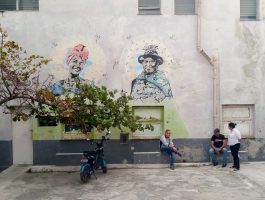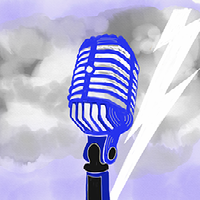15 Influential, Iconic, and Inspiring Women Writers Through History
Come into one of our Busboys and Poets bookshops and we can direct you to any number of wonderful books by women. From the high fantasy of N.K. Jemison to the sublime poetry of Joy Harjo to the intense investigations of Monique W. Morris we are proud to offer the work of so many amazing authors. We also want to make sure to acknowledge the incredible women writers of history. We believe that in order to make a brighter future we need to know the past, so let’s look back and demolish the myth that the writing woman is a new literary phenomenon.
1) Sumer 2285-2250 BCE: Enheduanna
The first known author in human history was Ur’s high priestess, Enheduanna. While we don’t really know too much about her (even Enheduanna is a title she gained upon taking her position as priestess) but we do know she was Sagon of Akkad’s daughter and one of the most powerful women in ancient Sumer. We know her hymns to Inanna are the first recorded instance of the religious hymns of southeastern Europe and southwestern Asia.
Her life was one of responsibility and intrigue. Along with penning (or more likely dictating the carving of) the first written texts she also helped to bring stability to the Akkadian/Sumerian empire and religion. While only so much can be gleaned after four thousand years we think being the first author, let alone one of the most powerful women of her time, earns Enheduanna a spot on our list.
2) Greece 610-570 BCE: Sappho
If we know little of Enheduanna we know perhaps even less of Sappho writing almost 2,500 years later. What there is of Sappho’s work and life comes down to us as echo and rumor. Described by contemporaries and future writers as both poet of undeniable skill and a woman of endless scandal the subject of Sappho’s life has always been one of controversy. What we do have is few names of family members and friends, a single complete poem, and several fragments.
But this surviving poetry remains literature of great skill and passion. Sappho tended to write about love (though it is unclear just how personal these poetic declarations were) and even now, 2,500 years after her death, her work remains as some of the most beautiful poetry of ancient Greece. For both the beauty of her work and the mark she left on the world-both ancient and contemporary-we remember Sappho.
3) Japan 975ish-1025ish: Murasaki Shikibu
Like our previous authors so much of Murasaki Shikibu is unknown. Even her name is pseudonymous. What we do know is that Shikibu was married and widowed at a young age (well, young by current standards) and that she soon after joined the court of Emperor Ichijo in the service of one of his consorts Akiko. It was while at court that she wrote The Tale of Genji, the first novel.
The Tale of Genji is a sprawling story of the charming prince Genji all the psychological turmoil that comes with his rather lascivious lifestyle. It extends past his death to chronicle the lives of his son and grandson as they take up their father’s mantel. This is of course a gross oversimplification of the complexity and delicacy of Shikibu’s work. With hundreds of characters, 54 chapters, and over 1,000 pages in a recent English translation The Tale of Genji is an ambitious novel by any measure. So for both her impressive accomplishments as an author and for igniting today’s most popular form of literature Murasaki Shikibu deserves our admiration.
4) 1364ish-1430 France: Christine de Pizan
Born in Italy, raised in France Christine de Pizan was one of the most educated and accomplished women of her time. By her mid-twenties Christine was widowed and left alone to provide for her children. She eventually secured patronage from several major families and was able to support herself by writing-no small feat even today. A prolific writer Christine produced both poetry and prose, but is most well known for her feminist texts.
The most famous of Christine’s work is easily The Book of the City of Ladies. Christine’s literary city is populated by and celebrates the accomplishments of the women that came before her. It is an argument for women’s liberation and acceptance as equal to men. But while it is her most famous feminist work (and indeed, one of the most famous feminist writings in the European canon) The Book of the City of Ladies is not the only time Christine fought against the misogynistic norms of Medieval Europe. From advocating for women’s education to attacking the sexist writers of both the past and present Christine never seems to be at a loss for words. Well, that is until the Battle of Agincourt after which she retired to a convent. But even there she continued to work, her final poem being in praise of Joan of Arc.
5) 1498-1547 India: Mirabai
So much of Mirabai’s life is mixed with legend, but what we do know of this poet and bhakti all revolves around her intense devotion to the god Krishna. Born into the ruling class of Merta, Mirabai was subject to intense social obligations for a woman of her standing. However from a very young age she gave all her love to Krishna. Even when she was married and then widowed by a royal of the Mewar family Mirabai dedicated herself to her god.
So scandalous was her religious fervor that her own family tried to kill her on multiple occasions. Yet it is said that on each attempt Krishna saved her, turning snakes, poison, and nails into things of beauty and harmlessness. Mirabai eventually left her home and traveled to Vrindaban, Krishna’s birthplace. As to her death, well the stories there are just as legendary as those surrounding her life. It is said that under continual persecution from her in-laws she eventually entered one of Krishna’s temples and merged with the god. But it’s not just her devotion that earns Mirabai a spot on our list, but her devotional poetry. While over 1,000 poems are attributed to her it is unclear how many are she authored. But even if we accept the low estimate of a couple hundred the poems are works of great beauty and emotion. Many express the longing of a lover for her beloved, the poignant suffering of their separation, and the beauty of their union. Not only was Mirabai about to transcend the restrictions of the world in which she lived but also she was able to create works of sublime loveliness and devotion.
6) 1650ish-1695 Mexico: Sor Juana Inés de la Cruz
Sor Juana Inés de la Cruz was a precocious child. Born the illegitimate daughter of Pedro Manuel de Asbaje and Isabel Ramirez, Juana had little access to formal education. So she taught herself with the help of her family library. By the time she was a teenager she had attracted attention through her writing and was asked to prove her intelligence to a panel of forty men from the University of Mexico. She passed with flying colors. She later gained the favor of viceroy and became his wife’s lady-and-waiting, an unusual feat for a girl born out of wedlock. However court life didn’t suit Juana and out of a desire to stay unmarried and dedicate her life to learning Juana joined a convent.
As a nun she had access to her own living quarters, amassed a library of exceptional size, and was free to consult with both scholars and courtiers. She also had time to write. Sor Juana’s poetry was notable for it’s skill and variety, covering a vast array of topics and styles. Her writing is also fiercely feminist, many of her narratives and poems focus on women and women’s experiences while her most famous essay “Hombres necios” takes on the hypocrisy of contemporary misogyny. In 1690 Manuel Fernández de Santa Cruz, bishop of Puebla published a critique of a 40-year-old sermon by Sor Juana and went on to admonish her. In response Sor Juana penned an uncompromising defense of women’s rights and education. While there is a certain degree of debate with regards to how much political pressure her response created it is known that several years later Sor Juana sold her books for alms (it is unclear as to whether she did so out of choice), publically repented, and in 1965 died caring for her sisters during a plague. Regardless of the circumstances surrounding her final years Sor Juana Inés de la Cruz was an exceptional woman well worthy of her nickname-The Phoenix of Mexico.
7) 1797-1883 USA: Sojourner Truth
Though she never learned to read or write Sojourner Truth’s speeches were ones of power and beauty. Born a slave Truth escaped her abuse in 1827 when an abolitionist family bought her freedom. Truth would go on to successfully sue for the return of her son and in 1828 moved to New York City where she would begin to work for a city minister. Her religious convictions grew and in 1843 she said the Spirit directed her to fight for universal justice. She soon started actively preaching for the end to slavery, for the rights of black people, and for women.
Though illiterate Truth dictated her memoirs, The Narrative of Sojourner Truth: A Northern Slave and started a lecture tour containing her famous Ain’t I a Woman speech. Interestingly enough the most famous version of the speech first given at the Women’s Rights Convention of 1851 had a completely different tone and wording than the more well-known version recorded in 1863. But regardless of the exact speech, it is perhaps Truth’s most famous work. Among her peers Truth’s insistence that black people and woman receive the vote simultaneously was the exception. But though she was dedicated to women’s rights she is remembered most of all for her work as an abolitionist. During the years of legal slavery Truth lectured for freedom, and when the Civil War began she provided material support for the Union armies. Even after the Civil War she continued to work for racial and sexual justice, fighting segregation, helping newly freed slaves, and speaking out for women’s suffrage. Through her words and her work Sojourner Truth was one of the strongest and most notable activists of her time.
8) 1797-1891 UK: Mary Shelley
Born to radical parents Mary Wollstonecraft and William Godwin, Mary Shelley’s had a stormy childhood and a downright tempestuous adulthood. For the first few years of her life Mary’s father doted upon her, but upon marriage to Mary Jane Clairmont their relationship grew more distant. Yet despite never receiving formal schooling Shelley (then Godwin) was a very intelligent young girl and learned from her father’s extensive library. When she was a teenager the young woman would meet a student of her father’s Percy Bysshe Shelley and the two would begin their affair while he was still married. While her father tried to force them apart the young lovers eloped and fled to Europe where they would meet Lord Byron and spend one particularly memorable summer on Lake Geneva where Shelley would write the first science fiction novel, Frankenstein.
Even if you’ve never read Frankenstein the story has become an established part of popular culture. A brilliant scientist, a neglected monster, Shelley’s tale has captured our collective imagination. And for a woman so affected by life and its loss her story makes a sort of sorrowful sense. Shelley’s mother died just a few days after her birth, one of her sisters died soon after she eloped, three of her four children never lived to see their first decade, and (admittedly after Frankenstein) her husband would drown. Needless to say Shelley was familiar with heartbreak. Not only did she face such death she also suffered from dissatisfaction with the eccentric Romantic lifestyle and her husband’s affairs. Yet even after all that she seemed to maintain a certain degree of affection for the man, immortalizing him in her novel The Last Man and supposedly holding onto his calcified heart as a keepsake. By the time of her death at the end of the 19th century Shelley would have firmly earned her place as the creator not only of numerous texts, but an entirely new genre.
9) 1862-1931 USA: Ida B. Wells
Ida B. Wells was born into slavery six months before the Emancipation Proclamation in Mississippi. She left school young and began to teach professionally after several older members of her family died of yellow fever leaving her younger siblings without a caretaker. Wells and her family would eventually settle in Memphis Tennessee. 1884 found her first foray into the world of political activism when she refused to move from the first class of a white train car. She would go on to unsuccessfully sue the C&O railroad in what was the first of many long fights for racial justice.
Most famously she wrote against lynching, starting when three friends were hanged after their black-owned grocery store started to attract customers from white businesses. The owners, Tom Moss, Calvin McDowell, and Will Stewart, were protecting their establishment when attacked. They fought back and were placed under arrest, yet before trial their white townsmen kidnapped and murdered the three. In response Wells started a series of articles on lynching in the south. It is difficult to overstate the dangers of a black woman investigating and writing about these murders. When one article particularly inflamed Memphis her newspaper’s offices an angry mob destroyed her office. Wells was advised to stay away from the city if she wanted to keep her life. It was a noteworthy end to her time in Memphis. She continued to write about lynching from New York culminating in the books Southern Horrors and A Red Record. Wells took her crusade across the country to Washing DC and across the sea to Europe. It was a fight she would continue into her death in 1931.
10) 1867-1940 Lithuania, USA, Russia: Emma Goldman
Born in Lithuania with a childhood in Russia Emma Goldman was raised to be a proper Jewish wife. Her life and works would in fact be rather less conventional. Goldman left Russia at the age of 16, settling as a factory worker in New England. It was during her first years in the US that Goldman first started her on the path to becoming one of the 19th centuries most notorious radicals. It was the Haymarket Riot that signaled a change in her life with Goldman heading to New York City. There she quickly joined the active anarchist circles at the time and started speaking passionately in both Yiddish and English. It was also where she began an affair with Alexander Berkman and supported his attempted assassination of industrialist Henry Clay Frick. Berkman was sentenced to over two decades in prison; there was not enough evidence to indict Goldman. Her radical politics and speaking engagements did not escape notice and authorities tried to tie her to unrelated acts of violence. They were unsuccessful until 1893 when Goldman advocated for the poor and hungry to simply take what they needed to survive. She was sentenced to ten months.
But her most well known accomplishment was the radical journal, Mother Earth that ran from 1906 until 1917. Mother Earth became perhaps the most influential radical journal of her time and covered topics of anarchy, sexuality, and free speech. But with the 20th century came laws of sedition and it was under such laws that Goldman would be deported to the Russia in 1919. After the Communist Revolution Goldman started to speak against the repressive policies of the USSR. It was in and in response to Communist rule the Goldman lost her tolerance for political violence. It is also where she wrote her scathing indictment on the USSR My Disillusionment in Russia. She would spend the rest of her life working for anarchism, socialism, free speech, reproductive rights, and sexual liberation. Though she would never feel at home outside of the US her exile was a time of prolific writing including her memoirs, Living My Life. She returned to America in death and was interred in Chicago with the bodies of many of her political brethren.
11) 1879-1938 USA: Zitkala-Sa
Born under the name Gertrude Simmons to a Yankton Dakota mother and white father, Zitkala-Sa spent her childhood in the South Dakota reservation before being taken to a Quaker missionary school at the age of eight. Her time at school was deeply affecting and in later years she wrote of being unmoored in both her family’s culture and that of America, a theme common to her writings. However despite her dissatisfaction with the school she returned in later years before enrolling in Earlham College. She would eventually take a position teaching at the Carlisle Indian Industrial School. However her tenure at Carlisle was not a pleasant one. Zitkala-Sa disapproved of the school’s harsh discipline and efforts to wipe out her student’s cultural identities. During her tenure she started to publish short stories and essays, many reflecting her disapproval for the institution. In 1916 she became the secretary, liaison, and magazine editor for the Society of the American Indian. In 1926 she founded the National Council of American Indians advocating for and investigating the abuse of Native Americans.
Zitkala-Sa was deeply concerned with assimilation and the preservation of Native American culture. She wrote extensively about her youth on the reservation and at residential schools. There were also more general essays on her experiences living between her own culture and that of white America, one of the most well known being Why I am a Pagan wherein Zitkala-Sa writes an open rejection of Christianity and Christian missionaries. Yet along with her autobiographical work Zitkala-Sa also published a series of retold Dakota folktales Old Indian Legends, a series of short stories, and the opera The Sun Dance. When she died in 1938 she left behind an impressive body of work preserving her life between two cultures.
12) 1882-1941 UK: Virginia Woolf
Born into a life of comfort Virginia Woolf was a brilliant child. Though she was denied the childhood education of her brothers Woolf was a voracious reader and would eventually study at King’s College London. During her youth Woolf also faced a number of losses, her mother and sister in adolescence and her father in early adulthood. It was in childhood that she first showed signs of the deep depressions that would appear throughout her life and to which she would eventually succumb. But when healthy Woolf was by all accounts charming, engaged, and energetic. While in London she became one of the Bloomsbury group, a liberal collection of modern artists. It is also where she would find and marry Leonard Woolf. Though their marriage lasted until her death Woolf was also known to carry on affairs with women, most notably the poet V. Sackville-West. As she aged Woolf was subjected to many varieties of “rest cures” which made their way into her writing. In 1941 Woolf felt herself falling into another depression and fearing what was to come, ended her own life.
Woolf’s work is exceptional both in form and subject. A master of language, syntax, and tone Woolf’s books have a poetic, almost musical quality to them. Her writings took from her life in tone and topic. Mrs. Dalloway followed her own experiences with doctors, To the Lighthouse captured elements of her own childhood excursions to the shore, A Room of One’s Own reflected her feminist politics. And Orlando was a stunning a love-letter Sackville-West. And all infused with her fierce wit and philosophy. Woolf still stands as one of the most revolutionary authors of her time and an undeniable force of modernism.
13) 1882-1961 USA: Jessie Redmon Fauset
Born in New Jersey as the 19th century was drawing to a close Jessie Redmon Fauset was an incredibly intelligent child, attending the prestigious Philadelphia High School for girls before going on to Cornell University. After University she would go on to teach French in Washington DC, but it was only later when she headed north that she truly found a place for her sterling intellect, in the Harlem Renaissance. In 1919 Fauset accepted an editorial position for W.E.B. Du Bois’s The Crises where she encouraged the work of her fellow artists as well as where she found a home for her own writing.
Though she was an instrumental part of the Harlem Renaissance Fauset went unrecognized in her lifetime. Her work about the Black middle-class was unusual for the time and making it difficult for Fauset to find a publisher and an audience. Yet despite her anonymity American literature owes her an incredible debt. Her work preserved an aspect of Black history often ignored by her contemporaries and her tireless work for the literary world helped usher one of the most fruitful and brilliant periods of American art.
14) 1889-1966 Russia: Anna Akhmatova
Born Anna Adreevna Gorenko into an upper-class family in 19th century Russia Anna Akhmotava faced family disapproval for her chosen profession. So she adopted a pseudonym and kept on writing. A member of the artistic movement Acmeism, her work focused on the material world in direct opposition to the Symbolism popular at the time. Akhmatova reveled in tradition poetic structure, though her own life was rather more freewheeling with a string of lovers and long cabaret nights. However her dedication to the aesthetics of old Russia would cost her after the Communist Revolution. As her friends were leaving the new USSR Akhmatova’s work starts to focus on her home, on her love for and inability to leave her land.
The USSR was not kind to Akhmatova; depicting her as immoral and dated her work was first unofficially blacklisted and then openly banned in 1925. She was able to make a living in literary scholarship and translation, and she never wanted for admirers, but still, this censorship was an incredible hardship. Her poetry became subversive to the point that she was risking arrest, but still Akhmatova wrote in secret. Her silence was broken briefly in 1940 with a selection of published poems, however they were soon withdrawn under political pressure. But in the end of WWII Akhmatova was allowed a radio voice in order to inspire Leningrad. Unfortunately such freedom was short lived. In 1949 her son and lover were arrested and sent to the Siberian gulags. She attempted to win their release with a series of sycophantic poems in praise of Stalin, but to no avail. Her son would live to see the outside; her lover was not so lucky. When she died Akhmatova had managed to regain some measure of literary freedom in her home country, and was regarded with respect abroad. Even today she stands as a reminder and recorder of Russia before and after the Bolshevik revolution and remains one of the most celebrated of poets.
15) 1891-1960 USA: Zora Neale Hurston
Born in Alabama, raised in Florida, and settling in New York, Zora Neale Hurtson was a figurehead for the Harlem Renaissance. Hurston’s childhood was spent in Black town of Eatonville, Florida where she would live until the age of 16. She took a job as a maid with Gilbert and Sullivan and headed north. Finding herself in Maryland in 1927 Hurston shaved ten years off her age in order to qualify for state education before heading off to Howard University and then earning a scholarship to Barnard where she studied anthropology. Her academic background would prove useful in her career as she went on to study folklore and religion in Haiti. While in New York Hurston became an active part of the Harlem Renaissance. Not only was she known for her work, but also her home became a gathering place for the many talented artists in the city.
Hurtson published a collection of southern Black folklore and later a study of Haitian voodoo. But Hurston was most well known for her fiction, especially her masterful book Their Eyes Were Watching God. Yet despite it’s acceptance as one of the finest pieces of American literature the book initially received a great deal of criticism. She was accused of sentimentality, sensationalism, and playing to White audiences. Hurston would eventually die in poverty, with not even enough money for a headstone. It was only in the 1970s when author Alice Walker paid for her grave. The date of birth read 1901, just as Hurston asserted throughout her life. Undoubtedly she would have been pleased.





